In Serie A, Caligari occupy 16th position with 26 points after 29 matches, far only by two points from the relegation zone, where Frosinone currently resides in the eighteenth position with 24 points.
On the offensive front, Claudio Ranieri’s side has scored 29 goals, in the seventh position as the worst attacking line, with a seven-goal difference from Empoli, who possesses the weakest defensive line, conceding 22 goals. However, defensively, the situation is dire as they have conceded 50 goals, marking them as the fourth worst defensive line after Frosinone, Salernitana, and Sassuolo, who have conceded 60, 59, and 56 goals, respectively.
Upon closer examination of the defensive statistics, it has been discovered that they have conceded 14 goals out of the total 50 goals from set pieces, accounting for 28% of the conceded goals. Moreover, it is noteworthy that they are the team in Serie A that has conceded the most goals from set pieces, further accentuating the issue at hand.
Most of these conceded goals have been through corner kicks, and upon examining their defensive system, it was found that they employ a hybrid system, utilising a blend of zonal-marking and man-marking players. However, throughout their journey, changes have been made to this structure, whether in the number of zonal defenders or the roles of the players ahead of them, yet the problem persists. Upon further examination of this issue, we perceive from our standpoint that the problem lies not so much in the scheme itself but rather in the references that the players adhere to. It seems they struggle in certain situations, unsure of how to deal with them regardless of the initial defending structure.
In this tactical analysis, we will discuss the various tactics employed by Caligari in dealing with different situations regarding defensive corner kicks, aiming to uncover the root cause of the problem, which appears to be unrelated to the type of defensive system being used.
Leaving the rebound zone empty
The first problem we are going to mention is that the rebound defender leaves the rebound zone empty for many reasons, such as helping the man markers, standing more forward, aiming to exploit counter-attacks or acting with a reference of man-marking with any attacker starts on the rebound zone so that he can be dragged easily and this caused many problems to them, as we will explain with cases below.
In the photo below, their recent defending system is clear by using five zonal defenders on the first zonal line, a zonal defender in front of them to defend flicks and go to help in case of short corners and three players whose role is to block any runner trying to run from the area around the penalty spot toward the six-yard aiming to prevent them from reaching there or at least prevent them from jumping from movement achieving dynamic superiority against the zonal defenders on the six-yard, so they leave any player between the penalty spot and the zonal line free where he will face a zonal defender, as in the second photo below.
Going to our problem, which is leaving the rebound zone empty, you can notice that there is only one blue defender for short and rebound areas, so he can be easily dragged to the short area to target the rebound zone directly. Here, we should mention that the opponent’s starting with many players a little in far positions between the penalty spot and the edge of the box is a trigger for them to dispense with the rebound defender to increase the blockers.


The taker crosses the ball directly toward the rebound zone, where an attacker can shoot it directly, as shown in the photo below.

In the previous case, the shot was from a far distance, so you may say that it looks good, but the possibility of scoring a goal from that chance is weak, and you are right. The ball was kicked outside in the previous case, but there are still many other ideas can be done, as we will explain below.
In the case below, they are still using three blockers, leaving the rebound zone empty, but the runners drag them deeper inside the box to make the targeted player nearer to the goal. The other trick is using a fake runner from the edge of the box in front of the defender who goes to help in case of short corners to drag him and also to drag the main short-option defender away from the direct passing lane.

Now, the targeted zone and the direct passing lane are empty, and everything is okay, but attackers should have blocked the defenders who can run quickly to defend against this possible danger, as already happened, as shown in the second photo below.


In this case, a similar idea is used, but it was more effective and ended with a goal. In the first photo below, many runners start near the edge of the box to drag the rebound defender, making him act as a man marker. They make sure that he won’t annoy the arrowed attacker, who will run freely to receive behind the short-option defender.
In the second photo below, the flick defender goes to help, but he is late, so the attacker can get the ball to the empty area he left while the attackers wait inside the six-yard for the pass, as shown in the third and fourth photos below.
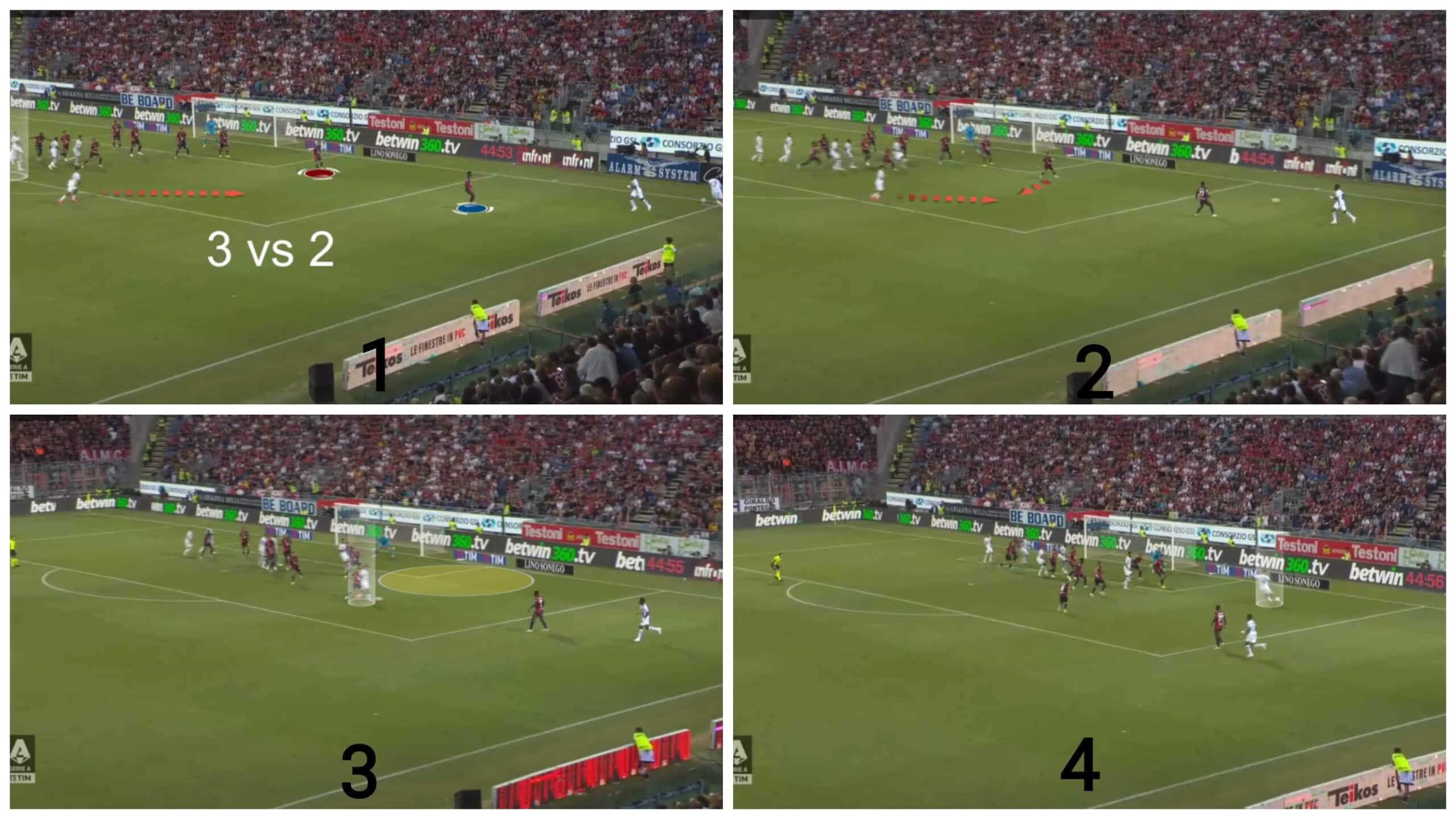
The plan works, and the result is a goal, as shown below.

Problems at defending on the near post
The second problem we will talk about is defending on the near post, whether against direct shoots, in out-swinging crosses, or against flicks, in case of in-swinging crosses, as we will explain in detail.
Starting with out-swinging crosses, we are still in the problem of references, so players don’t know who should fill the space between the player who goes forward to defend flicks and the zonal line behind him so that you can see in the first photo below the same defending system, but the question that the players can’t answer is who will fill the space behind the white-highlighted defender when he goes forward trying to get the first touch to defend flicks leaving a big space between him and the red zonal line behind him.
What increases the problem is that the zonal line is shifted toward the far post due to the predicted out-swinging cross. You can notice that the first defender isn’t aligned to the near post, so the targeted space is large, and opponents can target the goal directly without even flicks.
In the second photo below, the targeted player starts near the six-yard line, so he isn’t marked, as we have explained above. Then, as shown in the third photo below, he goes behind the first zonal defender out of his sight.
What we should also mention is the early, usual movement from their flick defender, which makes the targeted gap appear without a need for that, as shown in the fourth photo. This defender should be good at getting the first touch and measuring the ball in the air with a good shape to see the opponent and decide the right moment to go forward.
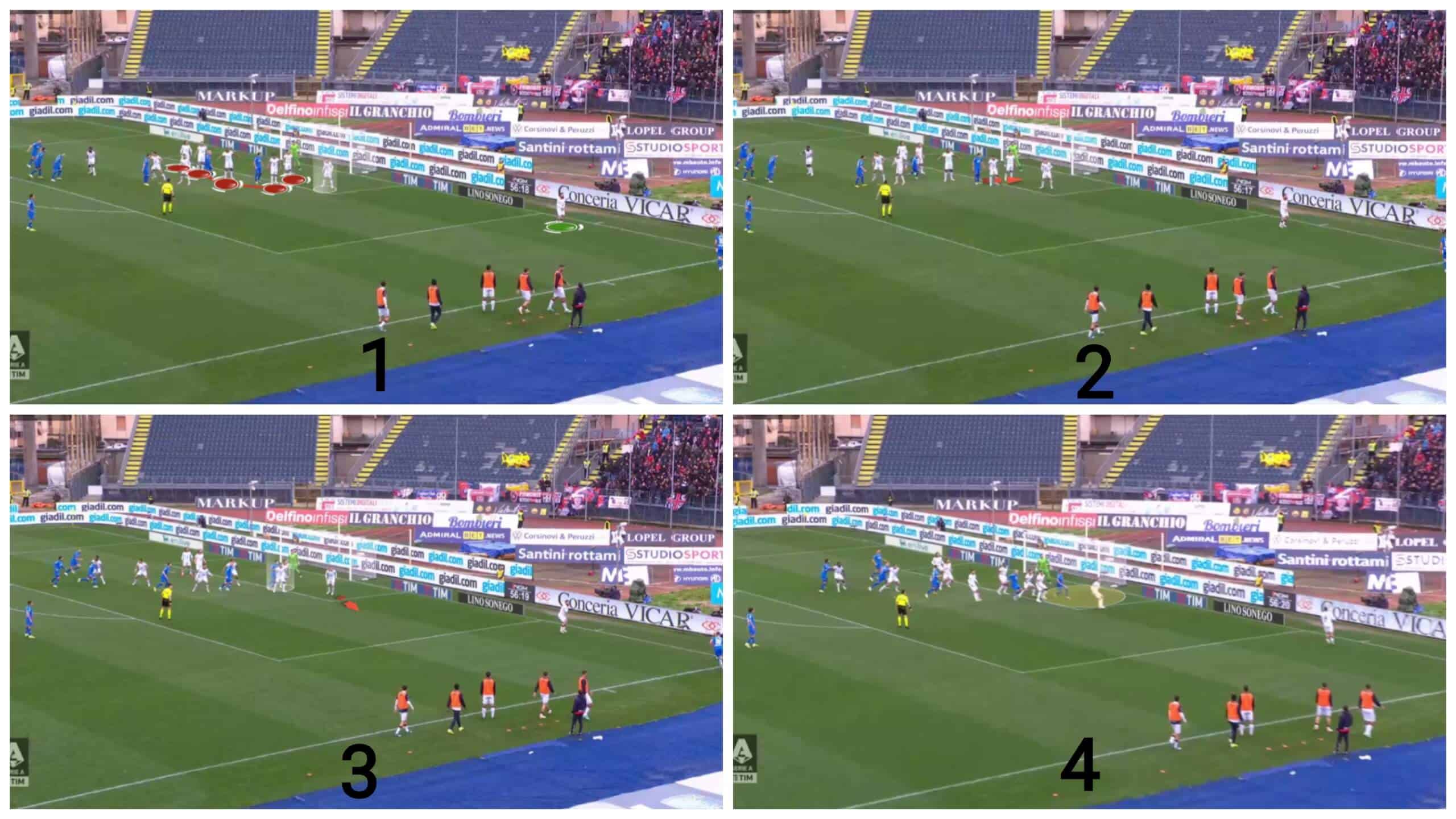
The plan works and the attacker gets the ball in this dangerous area trying to put it into the net directly, but it goes next to the post, as shown below.

In the first photo below, the same defence scheme appears, but in the case of in-swinging crosses, opponents try to flick the ball because the line takes care of this area by busting two attackers: A player starts outside the six-yard line and moves to the corner of the six-yard line to drag the flick defender, and a player inside the six-yard line moves from the back of the first defender, targeting the same area in the case above.
In the third photo, the first attacker is left without marking when he crosses the blockers’ area before playing the corner, so the flick defender goes forward for him. In the fourth photo, the first zonal defender should be instructed to fill this area in the blue arrow. Still, as in the previous case, no one goes to fill the gap, so the attacker coming from the back can flick the ball easily. In contrast, an attacker moves to the far post, dragging the last zonal defender in red, and a green attacker targets the area behind him, so now attackers are framing the goal, ready to receive the headed flick.
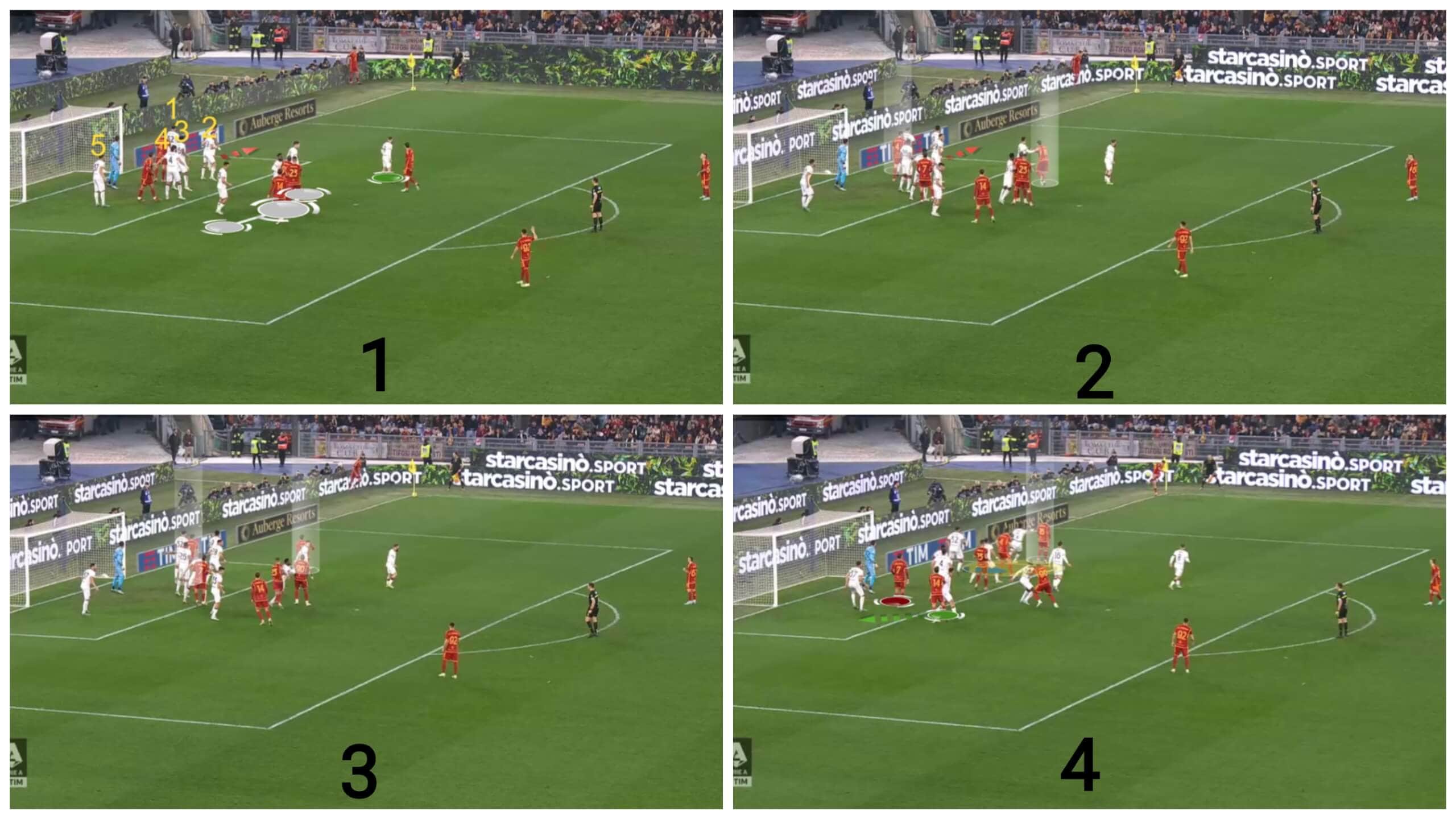
The plan works, but the targeted player can’t control the ball well, so it hits a defender’s hand, being a penalty after that.

Overloading near the penalty spot
Coming to the scheme itself, a problem appears when attackers overload the area near the penalty spot with four attackers, as shown in the first photo below, and then three attackers move in different directions, right and left, to empty the middle for the targeted player who had a good area to jump in before a zonal defender comes out, as shown in the rest of the photos.
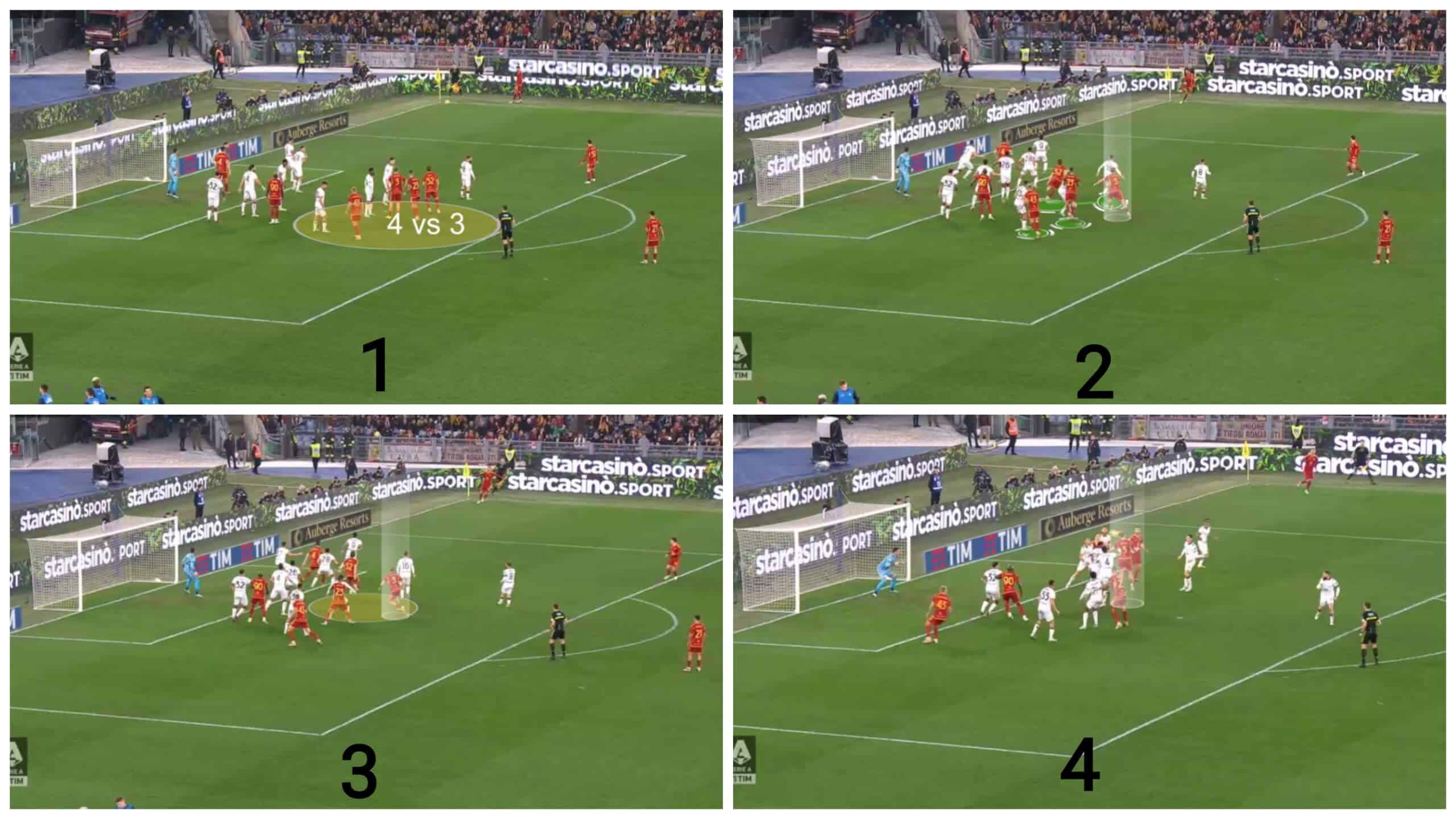
The plan works, and the result is a goal, as shown below.
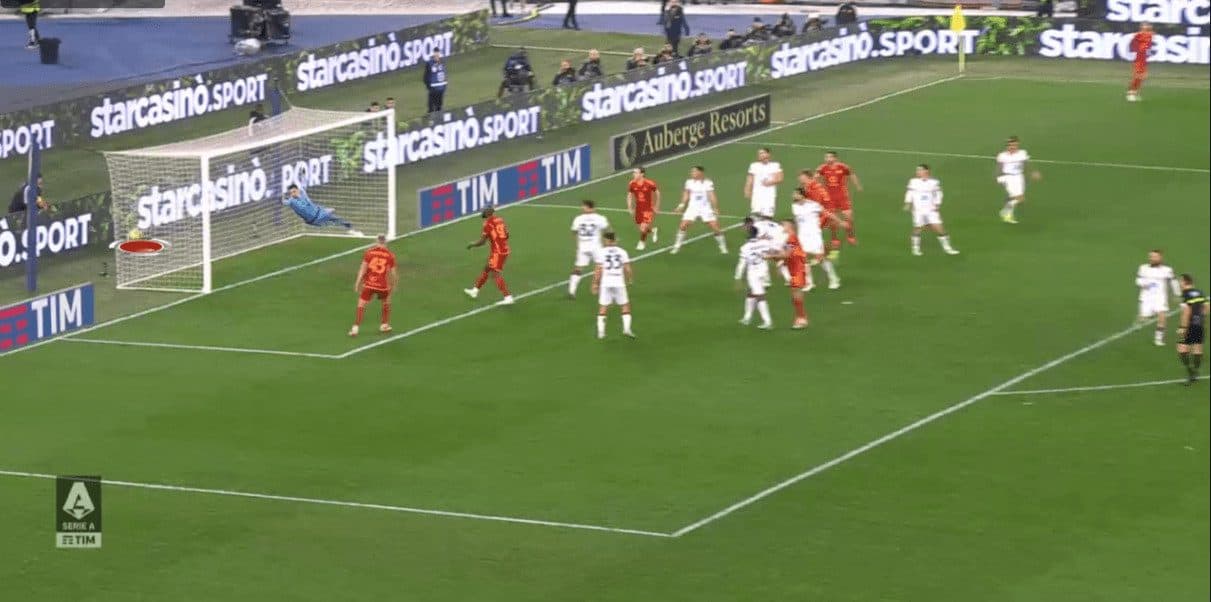
Conclusion
In this analysis, we have elucidated how Caligari have struggled in various situations concerning defensive corner kicks despite attempting to change their defensive structure.
In this set-piece analysis, we have explained that the rebound defender acts with a man-marking reference to help man markers inside the box, thereby leaving the rebound zone vacant. Furthermore, the lack of cohesion and clear communication among zonal defenders on the near post in dealing with flicks has been highlighted. Additionally, the structural loophole through using overloading near the penalty spot has been exposed.






Comments